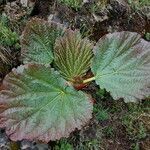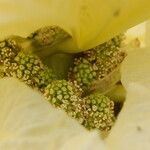Herbs large, 1-2 m tall. Roots and rhizomes stout, ca. 8 cm in diam. Stem erect, finely striped, stout, 2-3 cm in diam., glabrous, simple. Basal leaves in a rosette. Stem leaves dense; petiole stout, shorter than blade, 5-15 cm, glabrous; leaf blade large, orbicular, ovate, or cordate-ovate, 20-30 cm, nearly lea-thery, abaxially glabrous or pilose, adaxially glabrous, basal veins 5-7, conspicuously raised abaxially, base rounded or subcordate, margin entire, apex obtuse; distal leaves smaller upward, orbicular, 5-13 cm; ocrea red, broadly lanceolate, large, 10-15 cm, both surfaces glabrous. Panicle 5-8-branched, 5-9 cm, rarely with branchlets, glabrous; bracts light yellow, membranous when dry. Pedicel 2-3 mm, slender, jointed at middle or slightly below. Flowers 5-9-fascicled. Tepals 6 or fewer, connected at base, not spreading, elliptic, inner 3 larger, yellow-green, ca. 2 × 1 mm. Stamens (8 or)9; anthers compressed, oblong-elliptic; filaments compressed, base inflated, 3-3.5 mm. Ovary ovoid; style short; stigma inflated. Fruit broadly ovoid or ovoid, 6-7 × 5-6 mm, base rounded to slightly truncate, apex obtuse; wings dark brown, less than 1 mm, narrow, with longitudinal veins near margin. Seeds black-brown, cordate-ovoid. Fl. Jun-Jul, fr. Sep.
More
A herb. It grows to about 1.5 m high. It is densely covered with bracts which are pale and bend backwards. The leaves have stalks. The leaves are about 30 cm long and wide. They are oval or round. The base can be heart-shaped. The flowers are cream. These are hidden by the bracts. The fruit is dry and oval.
Rock ledges; at elevations around 4,000 metres. Open alpine grassy and rocky slopes, morainic deposits; at elevations around 3,600-5,000 metres.
More
A subtropical plant. In Nepal it grows between 3900-4300 m altitude. It often grows amongst rocks.


